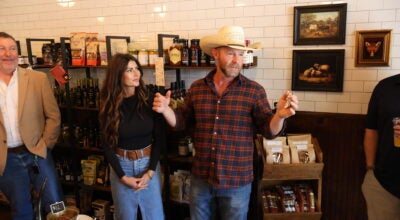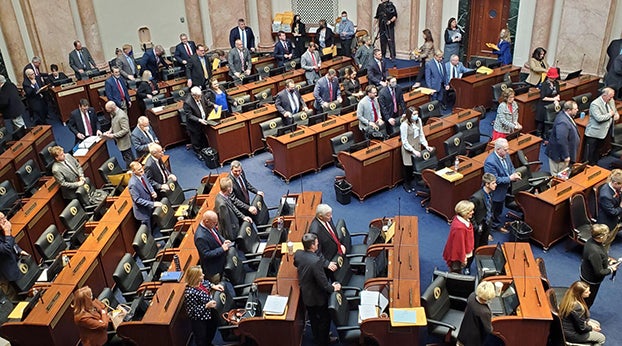Danville officer’s lawsuit against Norfolk Southern considered by Supreme Court
Published 12:44 pm Friday, September 15, 2017
The Kentucky Supreme Court will hear arguments in a Boyle County case next week, concerning a Danville police officer who fell down an embankment while pursuing an unruly suspect.
Sharon Johnson sued the railroad company Norfolk Southern after the June 2011 incident, alleging the company was liable for her injuries. A Boyle County jury determined that a legal precedent known as the “firefighter’s rule” prohibited Johnson from recovering damages, but the state Court of Appeals overturned that decision, ruling the firefighter’s rule did not apply and remanding the case for a new trial. Norfolk Southern appealed the Court of Appeals ruling to the Supreme Court, which will hear oral arguments in the case at 11 a.m. Sept. 21.
According to Norfolk Southern’s appeal, the 2011 incident began after Danville dispatch received “a lot of 911 calls concerning a white male with his pants down.”
Johnson and another Danville police officer, Sgt. Chris Matano, both responded to the area where the calls were coming from, south of Centre College’s campus near the Norfolk Southern lines that cross through Danville. Matano testified at trial that he headed to Dillehay Street after dispatch reported the person was “stripping his clothes off and walking up towards the stockyards,” according to the appeal.
Matano found the individual at the end of Dillehay Street — “the suspect was walking into the stockyards area wearing only his underwear,” according to the appeal.
“Sgt. Matano testified that the suspect’s eyes were closed and his fists were clenched. He refused to open his eyes because ‘demons were going to come out of his eyes if he opened them up,'” according to the appeal. “At this point, Sgt. Matano told the suspect he was under arrest and grabbed him. … The suspect pushed away from Sgt. Matano and started running.”
Matano testified that Officer Johnson had arrived at the scene as he began his pursuit of the suspect. Matano caught the suspect at the top of a hill and deployed his Taser, which caused the suspect to fall down the hill, according to the appeal. Matano then successfully navigated to the bottom of the hill in order to arrest the suspect. Officer Johnson arrived 20-30 seconds later, according to the appeal.
“Sgt. Matano heard Officer Johnson come over the hill and looked up. He saw her stumble and fall down the hill approximately 5-6 feet, onto the pavement at the bottom,” the appeal reads. “He was not sure whether she lost consciousness; he only recalls hearing a loud smack and Officer Johnson’s scream.”
Johnson had a somewhat different accounting of the event at trial, according to the appeal. Johnson said when she arrived at the stockyards, “the suspect was half-dressed and was ‘chanting, saying demonic things,'” according to the appeal.
Johnson testified she and Matano approached the suspect together, and when he wouldn’t comply, they both used their Tasers — but they had no effect, according to the appeal.
Johnson testified she remembers running a few steps before falling, but could not remember where she fell or what caused her fall, according to the appeal.
Johnson suffered injuries to her wrist and eye, according to court filings.
“Officer Johnson filed suit against Norfolk Southern Railway Company, claiming that the embankment was a dangerous condition on its premises and that Norfolk Southern is liable to her for her fall,” the appeal reads.
In ruling against Johnson, a Boyle County jury found that Johnson was barred from winning due to the “firefighter’s rule,” which is the precedent that responders such as firefighters and police officers cannot sue private property owners for hazards they encounter while performing their duties.
However, according to filings to the Supreme Court, the Court of Appeals determined the firefighter’s rule did not protect Norfolk Southern because the company was not the property owner who called 911, and because the risk of falling down a hill was not an inherent risk of the job she was doing.
Attorneys for Johnson argue the Court of Appeals was correct in its interpretation of the firefighter’s rule and the Supreme Court does not need to hear oral arguments.
Attorneys for Norfolk Southern argue the Court of Appeals ruled incorrectly — that the firefighter’s rule applies to any property that first responders must access for their jobs, regardless of who called 911; and that falling while pursuing an unruly suspect is not an unusual risk.
Norfolk Southern’s attorneys also argue that even without the firefighter’s rule, Johnson doesn’t have a case.
“In this suit, Johnson claims never to have seen the hillside, and that the hillside was an unreasonably dangerous condition about which Norfolk Southern should have warned her,” Norfolk Southern’s appeal reads. “To articulate this argument is to refute it. No reasonable fact-finder could conclude that Norfolk Southern had a duty to post “warning: HILL” signs near every natural embankment on every piece of property it owns — let alone a sufficient number of signs along the length of its railroad line so that (Johnson) would have been likely to see one of them while in hot pursuit of the suspect.
“But that is precisely what a jury would have to believe to find Norfolk Southern liable here for its failure to warn about the presence of a drop-off on private land, not open to the public, adjacent to a rail yard.”







